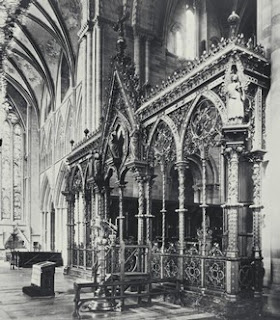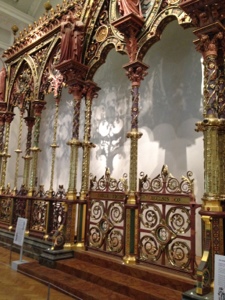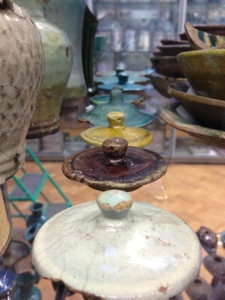Penny is all about the pattern and the patchwork!! We had a chat last week about how she might tackle her Berrington hall brief, we agreed that patchwork is a beautiful way to express her ideas and I'm delighted that she just popped into my office to show me this stunning patchwork booklet!!
Penny has been developing a swatch sample, complete with custom made metal stamped labels, to allow her to explore different types of patchwork.
All in all, a real delight to leaf through, touch and explore, I very much look forward to seeing how her ideas will develop!
You can follow Penny through her blog ( right hand side of this blog) called 'Rats and big Cats'!
We are Makers!!!We are Ceramicists, Jewellers, Blacksmiths, Sculptors, woodworkers and Crafts people who work and study at Hereford College of Arts, this is where we share our journeys, you are more than welcome to join us!
Tuesday 29 November 2011
Wednesday 23 November 2011
The last bits of London
Well, we have indeed returned from the Big City and it has to be said, everyone thouroughly enjoyed it! whilst we were there the students went to visit many exhibitions including The Power of Making and Dazzle, Del and I had a visited Covent Garden. It was an opportunity to see some amazing window displays.
We thought that this store front was pretty relevant to what we do here at Hereford, Explore, Discover, Inspire!
Well, its back to work untill the next trip in March to Amsterdam! Del and I are off to Made by Hand in Tradegar House tomorrow to set up our stand, so pop by and say hello if your around!
Kate and Del
x
Hereford screen, by Sir George Gilbert Scott, 1862
Its funny that we had to travell all the way to London to see a magnificent piece of metalwork that was origionally produced and located in Hereford Cathedral. the Cthedral in Hereford is a Magnificent building that has so much character it was a real pleasure to see the restored screen in the V&A in London.
Here is a little bit of history about the Screen itself.
The great choir screen made for Hereford Cathedral is one of the monuments of High Victorian art and a masterpiece in the Gothic Revival style. It was designed by Sir George Gilbert Scott, a leading Victorian architect, and made by the Coventry metalworking firm of Francis Skidmore.
A choir screen was essential to a medieval cathedral, as the barrier that separated nave from chancel, congregation from clergy. By the 19th century, most had been removed. Scott began to reinstate this medieval feature. He was noted especially for building new churches, but began to restore old churches in the 1860s. He aimed to reintroduce a sense of architectural and spatial cohesion, boldly adding modern work to achieve this.
Scott's most impressive screens were largely of iron, as at the cathedrals of Lichfield (1861), Hereford (1862) and Salisbury (1869-72), and all were constructed by Skidmore of Coventry. Medieval screens were not made of iron - then far too costly - but always of stone or wood. Scott regarded iron as an important 'modern' material and used it extensively, both structurally and decoratively.
Before it was installed in Hereford Cathedral, the screen was one of the major exhibits at the 1862 International Exhibition in London, and was praised the Illustrated London News as 'the grandest, most triumphant achievement of modern architectural art'. It helped to win for its maker a special medal for manufacturers in metal, brass and copper, for progress, elegance of design and excellent workmanship.
The jury report on the screen described it as 'one of the most important works, not only for its size, but for the care with which it has been executed, and the successful endeavours to treat what is in fact a large architectural subject in metal alone'. Christopher Dresser later singled the screen out in his Principles of Decorative Design (1872) as 'a correct and very beautiful treatment of material, one of the finest examples of artistic metalwork'.
Celebrated in the 19th century, the screen fell from favour in the 20th century. Aesthetically, it was seen as ugly and incongruous in a medieval building. Liturgically, it was held to form an unacceptable barrier between the congregation and the chancel area. In 1967 this masterpiece of Victorian ironwork fell victim to fashionable prejudice and despite a national outcry and the protests of John Betjeman, Nikolaus Pevsner and many others, the Cathedral authorities dismantled the screen and sold it to the Herbert Museum and Art Gallery in Coventry. The Herbert lacked funds either to conserve or to house it and in 1983 gave it to the Victoria and Albert Museum. The once rusty, disintegrated pieces have now been carefully conserved, returning the screen to its former splendour
Wendy Ramshaw at the V&A
If there is one thing I have learned during my time teaching, is that there is very little difference between Jewellery and Blacksmithing. Eventhough Wendy Ramshaw is not a blacksmith (neither is this gate forged) the simple fact that sometimes, the only things that defines us is scale!!!
Wendy has been making and designing jewellery for decades and has used her designs to their maximum potential and has applied them to large scale sculpture and gates. Its a great example of how a good designer can be versitile enough to cross the boundaries!
Albert Paley at the V&A
We obviously could'nt visit the V&A without seeing the worght iron work section! its wonderful to see how 'Handmade' has made such a massive contribution over the years, and within the permanent collection is one of Albert Paley's benches.
Albert Paley is the first metal sculptor to receive the coveted Lifetime Achievement Award from the American Institute of Architects, the AIA’s highest award to a non-architect. “The allure of Paley’s art comes though its intrinsic sense of integration of art and architecture,” as one noted architect stated.
Albert Paley has been active as an artist for over 30 years at his studio in Rochester , New York
Commissioned by both public institutions and private corporations, Paley has completed more than 60 site-specific works. Some notable examples are the Portal Gates for the Renwick Gallery of the Smithsonian Institution in Washington DC, a sculpture and plaza designed for Adobe Systems in San Jose, CA, the Portal Gates for the New York State Senate Chambers in Albany, a plaza sculpture for AT&T in Atlanta, GA, a 65-foot sculpture for the entry court of Bausch and Lomb’s headquarters in Rochester, NY as well as major entrance rotunda gates for a State Courthouse in San Francisco, and the main entrance gates for the Naples Museum of Art, Naples, FL.
Recently completed works include a sculptural relief for Wellington Place, Toronto, Canada, a pair of entrance sculptures for the Columbia Public Library, Columbia, Missouri, a 120-foot long entryway sculpture in Forrest park for the St. Louis Zoological Park, St. Louis Missouri, The Sentinel, a monumental plaza sculpture for Rochester Institute of Technology, and Threshold, an entryway sculpture for the headquarters of Klein Steel Services, Rochester New York.
Pieces by Albert Paley can be found in the permanent collections of many major museums including the Metropolitan Museum of Art in New York , the Museum of Fine Arts in Boston , the Museum of Fine Arts in Houston , and the Victoria and Albert Museum in London , Western Australia , Fitzwilliam, British Museum
Broadly published and an international lecturer, Paley received both his BFA and MFA from the Tyler School Art in Philadelphia University of Rochester in 1989, the State University of New York at Brockport in 1996, and St. Lawrence University, in Canton , New York
Tuesday 22 November 2011
A trip to Harrods at Christmas time
Well, you cant go to London without visiting Harrods! The Christmas lights are all up and the windows have been dressed, so Del and I took some of our Blacksmiths for a look around the food section at Harrods. Stuart is thinking of making a table setting for his work and we spent quite some time wandering around the food courts and being fed chocolate by people with white gloves!! So here's a little snapshot of what me, Del, stu, Lee and Nick got up to!
The ceramic display at the V&A
Well, as you know Del is a ceramicist, or as Adrian ( our big man at the forge) would call her, a mud slinger!! So Del got quite light headed and giddy at the sight of the new ceramic display upstairs in the V&A!!
There was soooooo much to look at and see it was hard to take it all in. Everything was organised in really interesting groups of objects where they shared a common theme, like the colour blue, printed theme, or country of origin. It was immense!!
There was soooooo much to look at and see it was hard to take it all in. Everything was organised in really interesting groups of objects where they shared a common theme, like the colour blue, printed theme, or country of origin. It was immense!!
Subscribe to:
Posts (Atom)





















































